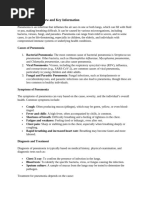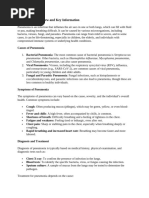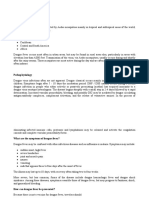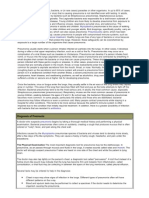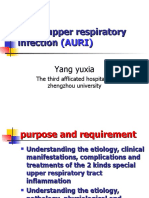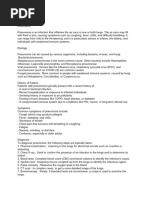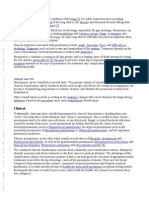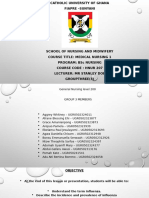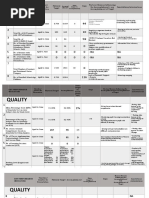Pneumonia 2
Pneumonia 2
Uploaded by
RomanCopyright:
Available Formats
Pneumonia 2
Pneumonia 2
Uploaded by
RomanCopyright
Available Formats
Share this document
Did you find this document useful?
Is this content inappropriate?
Copyright:
Available Formats
Pneumonia 2
Pneumonia 2
Uploaded by
RomanCopyright:
Available Formats
Pneumonia: Overview and Key Information
Pneumonia is an infection that inflames the air sacs in one or both lungs, which can fill with fluid
or pus, making breathing difficult. It can be caused by various microorganisms, including
bacteria, viruses, fungi, and parasites. Pneumonia can range from mild to severe, and in some
cases, it can be life-threatening, especially in children, the elderly, and individuals with
compromised immune systems or underlying health conditions.
Causes of Pneumonia
1. Bacterial Pneumonia: The most common cause of bacterial pneumonia is Streptococcus
pneumoniae. Other bacteria, such as Haemophilus influenzae, Mycoplasma pneumoniae,
and Chlamydia pneumoniae, can also cause pneumonia.
2. Viral Pneumonia: Viruses, including the respiratory syncytial virus (RSV), influenza,
and coronaviruses (e.g., SARS-CoV-2), are common causes of viral pneumonia,
particularly in young children and older adults.
3. Fungal and Parasitic Pneumonia: Fungal infections, such as histoplasmosis or
coccidioidomycosis, and parasitic infections can also lead to pneumonia, though these are
less common in healthy individuals.
Symptoms of Pneumonia
The symptoms of pneumonia can vary based on the cause, severity, and the individual’s overall
health. Common symptoms include:
Cough: Often producing mucus (phlegm), which may be green, yellow, or even blood-
tinged.
Fever and chills: A high fever, often accompanied by chills, is common.
Shortness of breath: Difficulty breathing and a feeling of tightness in the chest.
Fatigue and weakness: Feeling tired or lethargic, even after rest.
Chest pain: Sharp or stabbing pain in the chest, especially when breathing deeply or
coughing.
Rapid breathing and increased heart rate: Breathing may become faster and more
labored.
Diagnosis and Treatment
Diagnosis of pneumonia is typically based on medical history, physical examination, and
diagnostic tests such as:
Chest X-ray: To confirm the presence of infection in the lungs.
Blood tests: To identify the specific bacteria, virus, or fungus causing the infection.
Sputum culture: A sample of mucus from the lungs may be tested to determine the
pathogen.
Treatment for pneumonia depends on the cause:
Bacterial Pneumonia: Treated with antibiotics, which are chosen based on the specific
bacteria involved.
Viral Pneumonia: Antiviral medications may be prescribed in certain cases (e.g., for
influenza), but in most cases, the infection resolves on its own with supportive care.
Fungal Pneumonia: Requires antifungal medications.
Patients with pneumonia are often advised to rest, stay hydrated, and take over-the-counter
medications for fever and pain relief.
Prevention
Preventing pneumonia involves reducing the risk of infection and maintaining good respiratory
health:
Vaccination: Vaccines such as the pneumococcal vaccine and annual flu shots help
protect against common causes of pneumonia.
Good Hygiene: Regular handwashing and avoiding close contact with sick individuals
can prevent respiratory infections.
Quit Smoking: Smoking damages the lungs and increases the risk of respiratory
infections.
Healthy Lifestyle: A healthy immune system, supported by good nutrition and regular
exercise, can help protect against infections.
Conclusion
Pneumonia is a serious respiratory illness that can be caused by various pathogens, leading to
symptoms ranging from mild to severe. Early diagnosis and appropriate treatment are crucial to
managing the condition and preventing complications, especially in vulnerable populations.
Prevention through vaccination and good hygiene practices is key to reducing the incidence and
severity of pneumonia.
You might also like
- National Mental Health Plan 2023-2027Document100 pagesNational Mental Health Plan 2023-2027ScribdTranslationsNo ratings yet
- Self Learning Module in Fitness Testing and Basic Exercise ProgrammingDocument14 pagesSelf Learning Module in Fitness Testing and Basic Exercise ProgrammingROM EROS GALANG100% (1)
- Pneumonia 1Document2 pagesPneumonia 1RomanNo ratings yet
- Pneumonia 4Document2 pagesPneumonia 4RomanNo ratings yet
- Pneumonia 5Document2 pagesPneumonia 5RomanNo ratings yet
- Pneumonia 3Document2 pagesPneumonia 3RomanNo ratings yet
- 3 PneumoniaDocument17 pages3 PneumoniaMohamed Na3eemNo ratings yet
- Pneumonia 3Document8 pagesPneumonia 3janinecasilenNo ratings yet
- Pneumonia1Document4 pagesPneumonia1njanevidepettuNo ratings yet
- Pneumonia: Submitted To:Ms Lisette Cruz Submitted By: Ms. Mely Rose AbanadorDocument26 pagesPneumonia: Submitted To:Ms Lisette Cruz Submitted By: Ms. Mely Rose AbanadorJoyce Catherine Buquing UysecoNo ratings yet
- Symptoms of Bronchopneumonia in Adults and Children: PneumoniaDocument10 pagesSymptoms of Bronchopneumonia in Adults and Children: PneumoniajessyNo ratings yet
- Broncho PneumoniaDocument9 pagesBroncho Pneumoniamunie munieNo ratings yet
- Bronchopneumonia - MedscapeDocument7 pagesBronchopneumonia - MedscapecleoaerNo ratings yet
- Pneumonia: DR Abdul Ghani WaseemDocument20 pagesPneumonia: DR Abdul Ghani WaseemFarwaNo ratings yet
- PneumoniaDocument8 pagesPneumoniaNader Smadi100% (2)
- Case StudyDocument13 pagesCase StudyGeevee Naganag VentulaNo ratings yet
- PneumoniaDocument7 pagesPneumoniamuhammad murtazaNo ratings yet
- Name: Chintiya Cahaya Putri NIM: P20637020008 Class: 1A Prodi: Diii RmikDocument37 pagesName: Chintiya Cahaya Putri NIM: P20637020008 Class: 1A Prodi: Diii RmikChintiya PutriNo ratings yet
- Pneumonia: Pneumococcus. A Serious Complication of Pneumonia, Pneumococcal Meningitis, Is AssociatedDocument7 pagesPneumonia: Pneumococcus. A Serious Complication of Pneumonia, Pneumococcal Meningitis, Is AssociatedHannah YtacNo ratings yet
- Symptoms of Bronchopneumonia in Adults and Children: PneumoniaDocument10 pagesSymptoms of Bronchopneumonia in Adults and Children: PneumoniajessyNo ratings yet
- What Is Dengue Fever?Document30 pagesWhat Is Dengue Fever?Jeanie Rose AlduesoNo ratings yet
- PBLDocument7 pagesPBLRobelNo ratings yet
- Cardio AssignmentDocument4 pagesCardio AssignmentNeha SarfrazNo ratings yet
- Pneumonia WrittenDocument12 pagesPneumonia WrittenFereli Joy SupanNo ratings yet
- PneumoniaDocument16 pagesPneumoniaMelissa David100% (1)
- Pneumonia Is Caused by VirusesDocument6 pagesPneumonia Is Caused by VirusesrayshahNo ratings yet
- Acute Upper Respiratory Infection (AURI)Document58 pagesAcute Upper Respiratory Infection (AURI)api-19916399No ratings yet
- 3RD Quarter - Most Common Communicable Diseases and Its Prevention and ControlDocument7 pages3RD Quarter - Most Common Communicable Diseases and Its Prevention and ControlJocel May TaboradaNo ratings yet
- Pneumonia ( Jyoti)Document2 pagesPneumonia ( Jyoti)Vishnu Vardhan Reddy ChejerlaNo ratings yet
- QUARTER 3 - Communicablediseasesfinal-EditedDocument66 pagesQUARTER 3 - Communicablediseasesfinal-EditedJocel May TaboradaNo ratings yet
- PneumoniaDocument10 pagesPneumoniaKarylle ZairahNo ratings yet
- Topic 1: PneumoniaDocument45 pagesTopic 1: PneumoniaNektarios TsakalosNo ratings yet
- Pneumonia Is An: ClinicalDocument13 pagesPneumonia Is An: ClinicaldfgsfsfssdNo ratings yet
- DR BhanDocument1 pageDR BhanChalcho KanoNo ratings yet
- Causes of PneumoniaDocument6 pagesCauses of PneumoniaMd Sherajul HaqueNo ratings yet
- Pneumonia Is An Inflammation of The Lungs Caused by An Infection. It Is Also Called Pneumonitis orDocument6 pagesPneumonia Is An Inflammation of The Lungs Caused by An Infection. It Is Also Called Pneumonitis orOtrebron BatisanNo ratings yet
- Semester Chapter 2 - Special PathologyDocument209 pagesSemester Chapter 2 - Special PathologyALWIN SEBASTIANNo ratings yet
- Design Project 1 Group 2Document6 pagesDesign Project 1 Group 2Omar MragNo ratings yet
- What Causes PneumoniaDocument6 pagesWhat Causes PneumoniaJorge SegoviaNo ratings yet
- Pneumonia: DefinitionDocument5 pagesPneumonia: Definitionmbok diyirNo ratings yet
- Pneumonia and Its Type and Detail Note On ManagementDocument5 pagesPneumonia and Its Type and Detail Note On Managementarham.ahmad3112No ratings yet
- Pneumonia: Related Diagnostic TestsDocument2 pagesPneumonia: Related Diagnostic TestsBenj VillanuevaNo ratings yet
- Pneumonia: - Is An Infection of One or Both Lungs Which Is Usually Caused by BacteriaDocument10 pagesPneumonia: - Is An Infection of One or Both Lungs Which Is Usually Caused by Bacteriajdvea12No ratings yet
- PneumoniaDocument7 pagesPneumoniaMarichu Bajado100% (1)
- Biology investigatory project (1)Document25 pagesBiology investigatory project (1)Joe HamacherNo ratings yet
- PneumoniaDocument10 pagesPneumoniaJohn Philip M. Lacas RNNo ratings yet
- Pneumonia_٠٨٣٤٠٣_٠٨٣٦٥٤Document5 pagesPneumonia_٠٨٣٤٠٣_٠٨٣٦٥٤kbdh03978No ratings yet
- Kaushal - Pneumonia DiseaseDocument10 pagesKaushal - Pneumonia DiseaseKaushal PatelNo ratings yet
- PneumoniaDocument3 pagesPneumoniaAjay Supan100% (1)
- PneumoniaDocument55 pagesPneumoniaGlenn ValerioNo ratings yet
- Respiratory DiseasesDocument11 pagesRespiratory DiseasesMichael Angelo SeñaNo ratings yet
- Medical Nursing 1 (Group 3Document20 pagesMedical Nursing 1 (Group 3pauljesulayomiebelamuNo ratings yet
- Pneumonia Is An Inflammatory Condition of The Lung Affecting Primarily The AlveoliDocument3 pagesPneumonia Is An Inflammatory Condition of The Lung Affecting Primarily The AlveolimakkosetteNo ratings yet
- Community Acquired PneumoniaDocument5 pagesCommunity Acquired PneumoniaLau ColastreNo ratings yet
- Diagnosa Banding PneumoniaDocument7 pagesDiagnosa Banding PneumoniaLuphly TaluvtaNo ratings yet
- Broncho PneumoniaDocument5 pagesBroncho PneumoniamarkkkkkkkheeessNo ratings yet
- Lungs InfectionsDocument7 pagesLungs InfectionsMac PhersonNo ratings yet
- PneumoniaDocument10 pagesPneumoniaDina M ElbakaryNo ratings yet
- Presentation3Document29 pagesPresentation3Хмілецька ІринаNo ratings yet
- PneumoniaDocument13 pagesPneumoniaRobelNo ratings yet
- Bronchitis Control: Overcome This Ailment: Get A Handle On Your Bronchitis TodayFrom EverandBronchitis Control: Overcome This Ailment: Get A Handle On Your Bronchitis TodayNo ratings yet
- ABM 2Document2 pagesABM 2RomanNo ratings yet
- Diarrhea 4Document3 pagesDiarrhea 4RomanNo ratings yet
- Infantile Colic 1Document2 pagesInfantile Colic 1RomanNo ratings yet
- Constipation 3Document3 pagesConstipation 3RomanNo ratings yet
- Otitis Media 1Document2 pagesOtitis Media 1RomanNo ratings yet
- Iron Deficiency Anemia 2Document3 pagesIron Deficiency Anemia 2RomanNo ratings yet
- Meningitis 3Document3 pagesMeningitis 3RomanNo ratings yet
- Croup 1Document3 pagesCroup 1RomanNo ratings yet
- 2Document4 pages2RomanNo ratings yet
- 2Document3 pages2RomanNo ratings yet
- 1Document2 pages1RomanNo ratings yet
- Jurnal Skripsi Sabam GultomDocument3 pagesJurnal Skripsi Sabam GultomDavid Galatia TambaNo ratings yet
- Aravind Eye HospitalDocument5 pagesAravind Eye HospitalAkshay SachdevaNo ratings yet
- Planer Thicknesser: Original Instruction ManualDocument36 pagesPlaner Thicknesser: Original Instruction ManualAdam FreemanNo ratings yet
- NEERAJ KUMAR, AVTAR, (Students) JITENDER MEHLA (Research Scholar), NDRI and Dr. S.K. Sood, Senior Scientist, NDRI, KarnalDocument31 pagesNEERAJ KUMAR, AVTAR, (Students) JITENDER MEHLA (Research Scholar), NDRI and Dr. S.K. Sood, Senior Scientist, NDRI, KarnalAlokeparna Roy100% (1)
- Rekam Medik Rekam Medis, Medical ReportDocument8 pagesRekam Medik Rekam Medis, Medical ReportVicky RNo ratings yet
- Preton R-303 P - GBDocument10 pagesPreton R-303 P - GBzukhairi md rahimNo ratings yet
- The Impact of Career Development On Employee Job Satisfaction and Work Life Balance As A Mediator at PT. Telkom Indonesia (Persero) Bengkulu AreaDocument7 pagesThe Impact of Career Development On Employee Job Satisfaction and Work Life Balance As A Mediator at PT. Telkom Indonesia (Persero) Bengkulu AreaBetta Binti Joko SanyotoNo ratings yet
- Group-7 Proposed Alternative Business Strategies Among Restaurants in ArgaoCebu During Covid-19 PandemicDocument64 pagesGroup-7 Proposed Alternative Business Strategies Among Restaurants in ArgaoCebu During Covid-19 PandemicCharisse Jean PelominoNo ratings yet
- Nampicuan Christian AcademyDocument8 pagesNampicuan Christian AcademyMark Louie GollosoNo ratings yet
- 5a. Echo Evaluation of Mitral Stenosis, DR AzriDocument37 pages5a. Echo Evaluation of Mitral Stenosis, DR AzriJalu PanjongkoNo ratings yet
- Times: Rwf5bn Project To Promote Clean Cooking in RwandaDocument24 pagesTimes: Rwf5bn Project To Promote Clean Cooking in RwandaJohnson KwizeraNo ratings yet
- HBS Cases - Branding YogaDocument6 pagesHBS Cases - Branding YogaPraveenNo ratings yet
- The Johari Window: A Model For Soliciting and Giving FeedbackDocument23 pagesThe Johari Window: A Model For Soliciting and Giving FeedbackPooja varmaNo ratings yet
- Đề có 5 trang: by robots, report saysDocument5 pagesĐề có 5 trang: by robots, report saysNgọc Anh NguyễnNo ratings yet
- Additional Activities Health M1 Q4Document1 pageAdditional Activities Health M1 Q4secret88No ratings yet
- PE MODULE 2 Safety Protocols During ExerciseDocument29 pagesPE MODULE 2 Safety Protocols During ExerciseIya MercadejasNo ratings yet
- Taking Charge of Ones HealthDocument34 pagesTaking Charge of Ones HealthGreig WatsonNo ratings yet
- Bernet 2020 Five-Factor Model With Cover PageDocument16 pagesBernet 2020 Five-Factor Model With Cover PageFamily Court-CorruptionNo ratings yet
- HcgdPe Orpington Prognostic ScaleDocument2 pagesHcgdPe Orpington Prognostic ScaleArivuNo ratings yet
- Mam Mikay Dmea July 2022Document6 pagesMam Mikay Dmea July 2022Jade CartagenasNo ratings yet
- Goldfarb2020 PDFDocument15 pagesGoldfarb2020 PDFJulia Mar Antonete Tamayo AcedoNo ratings yet
- Vocab-Prepare Level 4Document13 pagesVocab-Prepare Level 4Hùng PhạmNo ratings yet
- Persuasive EssayDocument2 pagesPersuasive EssayJAZMIN HARO OROZCONo ratings yet
- Lesson 05. Mammary GlandsDocument23 pagesLesson 05. Mammary GlandsLola PNo ratings yet
- Overbite Depth Indicator and Anteroposterior Dysplasia Indicator Cephalometric Norms For African AmericansDocument6 pagesOverbite Depth Indicator and Anteroposterior Dysplasia Indicator Cephalometric Norms For African AmericansLiliana AguilarNo ratings yet
- Tyndale Rosenberg 2014 TheindependenttraditionDocument10 pagesTyndale Rosenberg 2014 TheindependenttraditionCastro Paredes Hannia CeciliaNo ratings yet
- 12th psychology QPDocument6 pages12th psychology QPzoyasalaha.tgisbNo ratings yet
- Folder - Tuberculose PulmonarDocument3 pagesFolder - Tuberculose Pulmonarsilvaenf5No ratings yet



